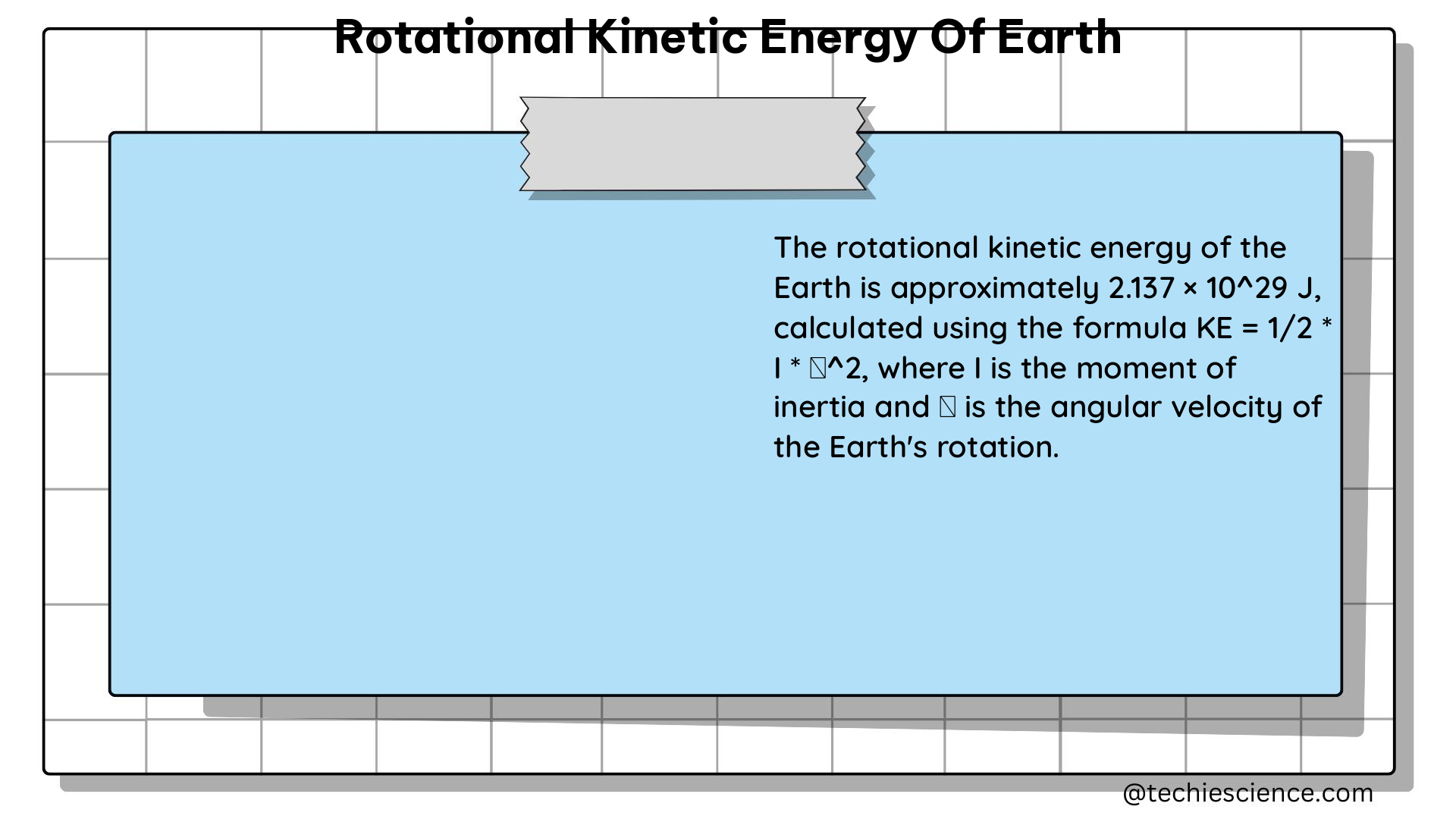The rotational kinetic energy of the Earth is a fundamental concept in physics, representing the energy the Earth possesses due to its rotation around its axis. This energy can be calculated using a specific formula and is influenced by various factors, including the Earth’s mass, radius, and angular velocity. Understanding the rotational kinetic energy of the Earth is crucial for understanding the Earth’s dynamics and its interactions with other celestial bodies.
Understanding the Rotational Kinetic Energy Formula
The formula for calculating the rotational kinetic energy of the Earth is:
KE = 0.5 * I * ω^2
where:
– KE is the rotational kinetic energy of the Earth (in Joules)
– I is the moment of inertia of the Earth (in kg·m²)
– ω is the angular velocity of the Earth (in radians per second)
The moment of inertia of a solid sphere, such as the Earth, rotating about its diameter is given by:
I = (2/5) * M * R^2
where:
– M is the mass of the Earth (in kg)
– R is the radius of the Earth (in meters)
Calculating the Rotational Kinetic Energy of the Earth

To calculate the rotational kinetic energy of the Earth, we need to substitute the known values into the formulas.
The relevant values for the Earth are:
– Mass (M) = 5.97 × 10^24 kg
– Radius (R) = 6.371 × 10^6 m
– Angular velocity (ω) = 7.27 × 10^-5 rad/s
Substituting these values into the formulas, we get:
I = (2/5) * M * R^2
I = (2/5) * (5.97 × 10^24 kg) * (6.371 × 10^6 m)^2
I = 8.04 × 10^37 kg·m²
KE = 0.5 * I * ω^2
KE = 0.5 * (8.04 × 10^37 kg·m²) * (7.27 × 10^-5 rad/s)^2
KE = 2.54 × 10^29 J
Therefore, the rotational kinetic energy of the Earth is approximately 2.54 × 10^29 Joules.
Factors Affecting the Rotational Kinetic Energy of the Earth
The rotational kinetic energy of the Earth is influenced by several factors:
-
Mass: The mass of the Earth directly affects the moment of inertia and, consequently, the rotational kinetic energy. A more massive Earth would have a higher rotational kinetic energy.
-
Radius: The radius of the Earth also plays a crucial role in determining the moment of inertia and the rotational kinetic energy. A larger Earth radius would result in a higher rotational kinetic energy.
-
Angular Velocity: The angular velocity of the Earth’s rotation is a key factor in the rotational kinetic energy calculation. A faster rotation would lead to a higher rotational kinetic energy.
-
Gravitational Interactions: The gravitational forces exerted by the Moon and the Sun can cause a gradual decrease in the Earth’s rotational kinetic energy over time. This is due to the transfer of energy from the Earth’s rotation to its orbital motion.
Practical Applications of Rotational Kinetic Energy
The understanding of the Earth’s rotational kinetic energy has several practical applications:
-
Satellite Dynamics: The rotational kinetic energy of the Earth affects the dynamics of satellites orbiting the planet, as it influences the gravitational forces acting on the satellites.
-
Tidal Forces: The rotational kinetic energy of the Earth is related to the tidal forces experienced on the planet, which are caused by the gravitational interactions between the Earth, the Moon, and the Sun.
-
Geophysical Measurements: Measurements of the Earth’s rotational kinetic energy can provide insights into the planet’s internal structure and composition, as well as its overall dynamics.
-
Time Measurement: The Earth’s rotation is used as a reference for timekeeping, and changes in the rotational kinetic energy can affect the accuracy of time measurements.
Conclusion
The rotational kinetic energy of the Earth is a fundamental concept in physics that provides valuable insights into the Earth’s dynamics and its interactions with other celestial bodies. By understanding the formula, the relevant factors, and the practical applications of this energy, we can gain a deeper understanding of our planet and its place in the universe.
References
- “Is the rotational KE of a rigid body considered as internal energy?”. Physics Forums. https://www.physicsforums.com/threads/is-the-rotational-ke-of-a-rigid-body-considered-as-internal-energy.985436/
- “Rotational kinetic energy when moment of inertia is changed”. Physics Stack Exchange. https://physics.stackexchange.com/questions/331621/rotational-kinetic-energy-when-moment-of-inertia-is-changed
- “10.4 Moment of Inertia and Rotational Kinetic Energy”. Suny Osuniversity Physics. https://courses.lumenlearning.com/suny-osuniversityphysics/chapter/10-4-moment-of-inertia-and-rotational-kinetic-energy/
- “What is the rotational kinetic energy of the earth? Assume the earth is a uniform sphere. Data for the earth can be found inside the back cover of the book.”. Vaia. https://www.vaia.com/en-us/textbooks/physics/physics-for-scientists-and-engineers-a-strategic-approach-with-modern-physics-4th/rotation-of-a-rigid-body/q-10-what-is-the-rotational-kinetic-energy-of-the-earth-assu/
- “10.23 | (a) Calculate the rotational kinetic energy of Earth on its axis …”. OpenStax Physics. https://www.youtube.com/watch?v=5LRis7-Vqa4
Hi ….I am Abhishek Khambhata, have pursued B. Tech in Mechanical Engineering. Throughout four years of my engineering, I have designed and flown unmanned aerial vehicles. My forte is fluid mechanics and thermal engineering. My fourth-year project was based on the performance enhancement of unmanned aerial vehicles using solar technology. I would like to connect with like-minded people.